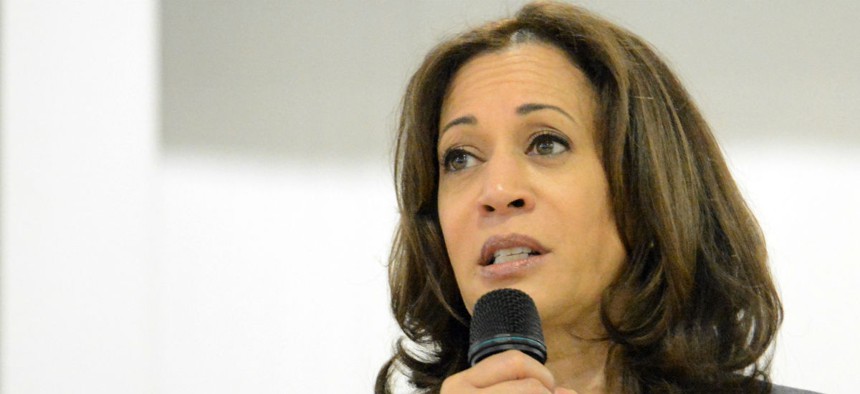Kamala Harris's $15 Million Proposal to Fix Local Government Tech

Sen. Kamala Harris Meg Kinnard/AP
The 2020 presidential candidate introduced a bill to help local governments modernize their digital services. Is this the lifeline cities need?
When Healthcare.gov crashed within two hours of its much-anticipated launch in 2013, it highlighted just how embarrassingly slow the federal government was in bringing its technology up to date. If there was a silver lining, though, it was that the site’s initial failure led to the creation of 18F and the U.S. Digital Service, two tech-savvy agencies that have since helped the government catch up with the times.
Now, a bill proposed by Senator Kamala Harris aims to throw a similar lifeline to local governments, whose digital infrastructure often remains painfully inept. “We must do more to empower our state and local governments to tap into the power of technology to provide seamless, cost-effective services for the 21st century,” she said in a statement.
The Digital Service Act of 2019, introduced Thursday, would allocate $15 million per year in grants to help states, cities, and Indian tribes establish their own team of tech experts and designers that will “update and rebuild” their digital services and online tools. Officials can apply for two-year grants of between $200,000 and $2.5 million, half of which is required to go toward paying the salaries of that team. The total amount awarded will depend on the size of a jurisdiction’s population.
Overseeing the grant distribution will be the U.S. Digital Service, which provides consultation to federal agencies. The agency, according to the bill, would review each applicant’s eligibility based on its ongoing commitment to “modernizing government technology” as well as “a rigorous commitment to digital delivery of government services.” It will also consider whether the government agencies applying for funds have a designated point person, like a chief technology or innovation officer.
The state of government technology varies wildly among cities. The more advanced ones have forged ahead to secure the latest smart technology, while others struggle with the most basic services. In many cases, employees still file paper by hand, data remains siloed within various agencies, and programs run on outdated softwarefrom as far back as the ‘80s and ‘90s. For some cities, even developing a user-friendly website is a challenge.
“Because we haven’t developed as much of the internal capability in government to just do digital things, to use technology in ways that, frankly, the average person uses them—not even programmers—technology actually becomes a barrier,” says Jen Pahlka, the founder and executive director of Code for America, which addresses technology gaps between the public and private sector.
Lacking the funding and skilled employees, some cities rely, instead, on buying software and systems from private companies. The process is often long and arduous, not to mention costly, and the end product can be clunky and non-user friendly. In fact, the companies that win government contracts often are not the ones known for modern software development, as Hana Schank and Sara Hudson, two public interest technology fellows at the think tank New America, wrote in the Washington Post last year.
While some governments have looked toward working with startups, Jay Nath, CIO of the civic tech nonprofit City Innovate, previously told CityLab that the partnerships often lead to a mismatch between what’s offered and what the cities actually need.
That’s not to say public-private partnerships aren’t important. “But they only work if the capacity of the city employees to manage and understand those relationships are at a high enough level,” said Stephen Goldsmith, director of the Innovations in American Government Program at the Harvard Kennedy School’s Ash Center. “You want to be in control of your vendors.”
That’s why “at least 50 percent of the money has to go to people,” said Pahlka, who helped set up USDS back in 2014 and whose nonprofit lent support to Harris’s team. “It’s not about states and municipalities just buying more technology and not building the internal capacity.”
While the strength in the bill lies in its focus on building teams, it also needs to help local governments retain those technologists over the long run. Considering how many cities lack an employee dedicated to technology innovation—let alone an entire team—$15 million is a small sum to be shared among several grantees who will have to compete with the more lucrative private tech sector for top talent. “I don’t know how you do that in the long term with this amount of money,” Goldsmith said.
Then there’s the question of which applicants USDS should prioritize—those that struggle with basic services, for example, or those with innovative ideas to move local government forward? The way Pahlka sees it, the department should start with those that have clear leadership and vision. Goldsmith wonders if the money could be better spent as “venture funding”—that is, funding breakthroughs and open-source solutions that can be scaled rather than individual governments and their employees.
It remains to be seen if Harris can garner enough support for the legislation to pass, though as Wired points out, there has been bipartisan support for investing in better government technology. If nothing else, the introduction of the bill is a symbolic gesture that there’s interest in Congress—or at least on the 2020 campaign trail—in investing in government at the local level.
“Across the world, many governments are investing substantial amounts of money into digital platform and data analytics. The U.S., not so much,” Goldsmith said, “But there is a fair amount of platform, shared services, and standard work that such a bill could further, so it’s a good idea.”
NEXT STORY: What Would a Dog Do on Mars?





